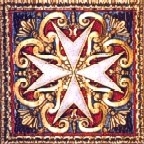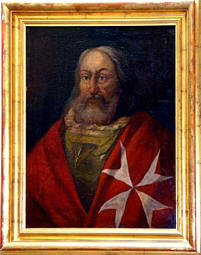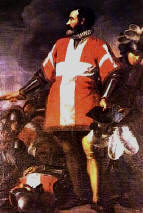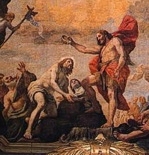|
HISTORY |
||
|
The Sovereign Military Order of Malta is both a Religious Order of the Catholic Church and an order of knighthood, reflecting the ancient concept first appearing in the eleventh century of monks dedicated to holy war. It is anachronistic to speak of monks of war but the concept must be viewed in the light of those ancient days when fighting for the Holy Land was not considered sinful but actually purifying and lofty in the eyes of the Lord. The Templars were the first order of European nobility executing these duties, carving a way to Jerusalem by brute force of will and steel. Many gave up family and goods and followed the cross to the land that knew the Lord Jesus, wanting to win back the sacred sites from the hands of the infidels. Not all who went, did honour to the Cross, for much barbarity was committed even by some hailing from the noblest families of Europe. But, after surmounting unbelievable hardship and terror, the conquerors did win the Holy Land, at least for a time. With victory, came the responsibility of guarding the roads and supporting the increase in the number of pilgrims, who now could visit the site of Christ’s earthly sojourn. In 1099, even before Jerusalem was taken, the Order of the Hospital was set up as a hospitium or Hospice Infirmary, administered by its founder Blessed Gerard.
On the 15th Febuary 1113, Pope Paschal II approved the constitution of the Hospital placing it under the protection of the Holy See and guaranteeing it freedom from any other ecclesiastical or even lay authority. There was a necessary Military side to the Order; the chief aims were those of “tuitio fedei” and “obsequium pauperum”, defence of the Faith; and the care of our lords the sick. Although the Order of the Hospital came after that of the Templars, it proved more than a worthy competitor in good deeds. Unfortunately anything made by man is liable to human frailty and the history of the Crusades is full of the constant rivalry, and at times actual fighting and even open warfare. Nonetheless, history also reveals innumerable heroic feats where Templar and Hospitaller shoulder by shoulder shed their blood for the Faith, such as the famous battle of Arsuf, half-way to Ascalon when under Richard The Lion Heart, they vanquished Saladin, till then undefeated since the ignominious Christian defeat at Hattin.
The period 1175 -1185 saw a peak in rivalry with the diminution of funds from Europe. Both Orders were of undoubted valour and unbreached bravery but the Hospitallers through their Hospitium were chiefly devoted to the care of the sick and the ill.
When the Islamic forces gained momentum and Jerusalem was again lost to the Saracens in 1187, the Knights first retreated to Acre, which also fell to the Turks. They then moved their headquarters to Cyprus in 1291 and to Rhodes in 1310, where they enjoyed territorial sovereignty for the first time. Suleiman I of Turkey attacked Rhodes in 1522, with a fleet of 400 ships and 200,000 men. Although the Order under Grand Master Phillipe Villiers de l'Isle Adam was well prepared for this attack, it was hopelessly outnumbered. After a six month siege, the decimated and half starved Knights were forced to surrender on Christmas Eve of that same year. Suleiman's admiration for the heroic stand of Grand Master l'Isle Adam and his Knights not only permitted the Knights to leave Rhodes unmolested, but were also given a ceremonial guard of honour to see them off in their own galleys. They were given the chance to recoup and fight another day.
The Knights were homeless for seven years and spent this period peregrinating in Nice, Civitavecchia, Viterbo and Syracuse in Italy. In March 1530 the Emperor Charles V of Spain offered the Maltese Islands as a perpetual fief for the annual rent of a Falcon. L’Isle Adam accepted the King’s offer as the harbours (which could not be offered elsewhere) were ideal for the Order’s maritime powers. He thus became the first Grand Master of “The Knights of Malta.”
The Order of St. John and the Island of Malta share many a historical chapter. Their liaison spans a period of 268 years namely from 1530 to 1798 during which time the Order was first to evolve into a respected power, and after the Christian battle of Lepanto in 1571, an indomitable maritime war machine. During the Malta phase, the Order was ruled by twenty-eight Grand Masters, the most well know being Jean Parisot de la Valette (1557-1568), in picture below, when the famous Great Siege of 1565 marked the bravery of the Order and the Maltese for ever in world history.
However the relationship of Malta and the Order goes much deeper and is weaved much more subtly and delicately than simply the world famous siege of 1565 of which Voltaire uttered the famous remark: “Rien n’est pIus connu que la siege de Malte.” The Malta period started from 26th October 1530 when the Order made its new home in Malta and ended when Napoleon Bonaparte, by various acts of treachery was essentially handed over the island with minimal conflict in 1798. But for more than two and a half centuries the magic of the cult of the Order of St. John worked its way into the Maltese way of life, be it in civil laws, medicine, culture and education. The eight pointed cross was worked on various stone-works, in lace and became etched deeply in the Maltese archetype, such that it became known as the Maltese cross.
The Knights built a myriad of Auberges,
Churches, Chapels, Gardens, Aqueducts, Streets, libraries, whole towns and
cities such as Valletta itself which became a treasure house of art. The
Order reached the height of its temporal power and became an international
Naval Academy. The Hospital or the Sacred Infirmary was founded in 1532 and
built in 1573. Grand Master Frà Raphael Cottoner continued the Hospitaller
tradition by enlarging and improving the premises to eleven wards for five
hunderd patients with a school of Anatomy and Surgery, a school of Pharmacy
and an illustrious medical team, which was a remarkable enterprise of
world-wide renown, the first international hospital in history.
Today the order is more vigorous and flourishing than ever, in the sole unbroken continuation of the Order of the Hospital of St. John, established by the Pope in 1113. It alone is a religious Order of the Catholic Church and at the same time an Order of Knighthood. It alone contains the governing nucleus of the professed Knights of Justice, direct successors of its founders. |
||
|
The Order Today |
||
|
The Order carries out its hospitaller and
charitable mission throughout the world through its Grand priorities and
National Associations as well as through its own diplomatic channels.
These manifold activities in no way interfere with the original aim of the Order - aid and assistance to sick pilgrims visiting the holy places. Every year Knights and Dames of the Order from all the countries from Europe and America accompany numerous sick persons on the International Pilgrimage of the Order to Lourdes and various other sanctuaries in different countries.
The Order now operates in over 120 countries, faithfully performing ''a mission of peace and solidarity in the service of the disadvantaged of every race or religion, offering those who suffer the same assistance as our predecessors did in the hospital in Jerusalem nine centuries ago''. |
||
|
Names of the Order |
||
|
||
|
Mimic Orders |
||
|



